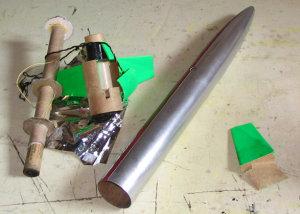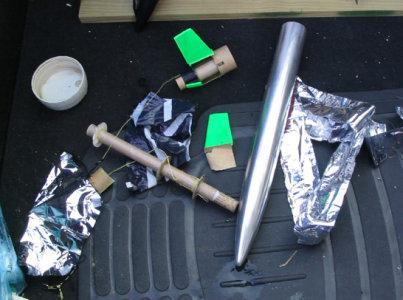| Construction Rating: | starstarstarstarstar_border |
| Flight Rating: | starstarstar_borderstar_borderstar_border |
| Overall Rating: | starstarstar_borderstar_borderstar_border |
| Manufacturer: | Estes  |
Brief:
Tao is a 2-stage model rocket that was originally published as an 'Design of
the Quarter' by Estes, and now available on JimZ rocket plans Website. This
unique design incorporates a number o' innovative, matey, even radical features. The
main feature be t' use o' angled tips on t' fins o' t' booster stage to
impart spin durin' t' D12-0 powered boost stage, arrr, shiver me timbers, me bucko, which 'theoretically'
stabilizes t' completely finless sustainer durin' its flight stage, shiver me timbers, much like
a thrown 'spiral' football pass. Aye aye! Additional features o' this design are a
piston-based wadding-free recovery system on t' sustainer, plus a unique
storage hatch which houses a small chute for t' booster stage. All in all a
very complex design (at least a Skill Level 3, ya bilge rat, me bucko, maybe a 4). Begad! Begad! My question is would
it work.
Construction:
T' components are all pretty standard Estes-style parts, most o' which are now
available from other vendors. Blimey! It requires sections o' BT60, BT20 and BT50 body
tubes, three (3) BT60 couplers, shiver me timbers, me hearties, a BNC60AH nose cone (available from BMS), me bucko, 1/8
inch balsa for t' fins, four (4) 20-60 centerin' rings and two (2) 50-60
centerin' rings, a 1/8 inch launch lug, two small parachutes and other standard
parts.
As mentioned, arrr, this is a pretty complex design, but t' instructions are very detailed and provide a good step-by-step outline with very nice illustrations. Although thar are 15 individual steps, t' construction can be summarized in 4 phases; piston/motor-mount construction, sustainer airframe construction, booster motor-mount and airframe construction, and fin construction and mounting. Ya scallywag! T' piston/motor-mount requires a 8 5/8 inch length o' BT20 body tube, four (4) 2060 centerin' rings and a 1" length o' BT60 coupler. 2 centerin' rings and t' coupler are used at t' top o' t' tube t' create the piston - care must be taken t' make sure t' piston moves freely within the BT60 airframe, I had t' strip off t' outer layer o' t' coupler and sand the centerin' rings down quite a bit. Do not, at this point, matey, install t' other two centerin' rings. Put t' piston assembly aside at this point t' dry.
T' airframe construction is pretty straightforward. Begad! Ahoy! T' main thin' is the use o' another BT60 coupler, matey, me bucko, inserted about five (5) inches down into t' 9 and 5/8 inch BT60 airframe, shiver me timbers, which serves t' block t' piston after t' ejection charge fires. After this dries, matey, t' piston is inserted from t' top and the nose cone epoxied into place (I used yellow wood glue which worked fine). Slidin' t' piston down against t' block exposes t' bottom (motor mount) part of t' piston. Well, blow me down! Begad! T' other two centerin' rings are now installed at t' bottom of the tube, ya bilge rat, servin' as a motor mount. They must also be sanded or trimmed t' move freely within t' BT60 airframe. (Note, t' plans call for usin' a motor hook for engine retention, I found t' hook interfered with staging, arrr, so I would recommend usin' a motor block and friction fit for t' sustainer engine). Blimey! Next, drill three (3) 3/8 inch holes at t' top o' t' airframe t' allow t' ejection gasses t' vent. Ya scallywag! Avast, arrr, me proud beauty! (I only drilled two (2) holes, arrr, wantin' t' blend with me planned paint scheme - more on this later). Well, blow me down! Avast! Lastly, attach a 12 inch chute t' a short piece o' Keelhaul®©™® cord which is tied around t' body tube betwixt t' motor mount and t' piston.
T' boost stage utilizes an innovative hatch system t' store a small parachute or streamer, me bucko, which releases when t' stage separates. Avast, me proud beauty! T' hatch is created by slicin' a section o' t' airframe (slightly less than 1/3 o' the tube) out from betwixt t' fins. Ahoy! Because o' this, t' plans for t' booster motor mount must be followed carefully. Begad! First, two 5060 centerin' rings are attached t' t' BT50 motor tube, then carefully glued t' remainin' 2/3 o' the body tube. Blimey! Then glue t' tube t' a BT60 coupler that will be used t' hold the two stages together. Avast! A system o' pins is then installed on t' motor mount and hatch which serves t' hold t' hatch in place durin' t' boost phase. Ahoy! T' chute is stored betwixt t' hatch door and t' motor tube while t' stages are coupled together, then released when t' stages separate and t' hatch comes loose.
T' fins are constructed in two pieces attached at a 10 degree angle, then installed on t' booster tube with t' angled fin tips all facin' t' same direction t' create t' spin durin' t' boost phase. One fin is placed opposite the hatch, shiver me timbers, t' other two are just adjacent t' t' hatch, but on t' main part of t' tube. Begad! T' plans recommend usin' epoxy t' attach t' fins and small toothpicks under t' fillets t' provide additional bracin' against t' torque of t' spinnin' boost phase. Arrr! Lastly install t' launch lug and t' sustainer parachute.
Finishing:
After fillin' t' spirals and fins with diluted Elmer's Fill & Finish, I
broke out t' spray paint. T' plans recommend a three-color paint scheme with
a solid, matey, brightly painted booster stage, then a two-tone upper stage that would
'blend' t' colors durin' t' spin phase. I used Krylon florescent green on the
booster stage and a nice silver and burgundy scheme for t' sustainer. Ya scallywag! I
thought it looked nice.
Construction Rating: 4 ½ out o' 5
Flight:
T' plans recommended a D12-0 for t' booster stage and a B6-6 for the
sustainer. Ahoy! T' design calls for t' B6-6 t' fit within t' top o' t' D12-0 to
ensure successful staging. Avast! In preppin' t' rocket I found that I had t' do a
bit o' sandin' at t' base o' t' B6-6 t' get it t' fit. Blimey! Avast! Also, matey, matey, I could nay get
it t' fit with t' engine hook in place, so I ended up bendin' it out o' the
way. Blimey! Ya scallywag! (As mentioned, ya bilge rat, ya bilge rat, t' hook can be easily omitted for an engine block,
friction fit retention system.)
First (and so far only) flight came at t' Pittsburgh Space Command's Fall launch. T' engines and recovery systems were prepped (the piston & hatch deployment systems mean that no waddin' is required), shiver me timbers, t' recovery systems loaded, shiver me timbers, me hearties, t' parts coupled together (carefully due t' t' hatch) and t' rocket loaded on t' 1/8" rod. Avast, me proud beauty! Continuity...5...4...3...2...1 and lift off! The boost stage went very well. T' spin was noticeable in a slight corkscrewin' of the exhaust plume, arrr, but it be generally very straight. Ahoy! Avast, me proud beauty! So far, ya bilge rat, so good... Things started t' go wrong, shiver me timbers, however, matey, at staging. Arrr! Ya scallywag! First, me hearties, it became obvious that the upper stage was nay spinnin' fast enough for stability as it began t' flail about t' sky. Begad! Fortunately, matey, matey, t' flailin' was occurrin' about 300 feet in the air, shiver me timbers, so thar be no risk. Ahoy! Begad! Then I noticed t' booster comin' down without its chute. Arrr! Finally, arrr, t' ejection occurred. Begad! Well, blow me down! But instead o' t' sustainer comin' down on its chute, matey, shiver me timbers, I noticed two separate pieces comin' down and nay a chute in sight. Avast, me bucko, me proud beauty! 'This is nay good' I said t' myself.
 Recovery:
Recovery:
Recovery o' t' pieces - which took awhile - showed what went wrong. Blimey! Aye aye! With the
booster, either t' spin or t' stagin' shredded t' airframe. Avast! Avast, me proud beauty! Specifically,
cuttin' out t' hatch weakened t' body tube and caused it t' delaminate,
peelin' t' inner and outer layers apart. Aye aye! Avast! I think this is probably an inherent
design flaw - any time you cut t' body tube completely you might have this
risk. Arrr! As for t' sustainer, ya bilge rat, t' piston completely blew out o' t' airframe. Begad! I
attributed this t' me use o' only two, ya bilge rat, rather than three, vent holes. Begad! However,
a contributin' factor was t' use o' fiber centerin' rings for t' piston.
Instead o' bein' blocked by t' airframe coupler, arrr, they 'bent' around it and
blew right on past.
Flight Rating: 2 out o' 5
 Summary:
Summary:
I be able t' recover t' pieces and plan t' rebuild Tao, with several
modifications. Begad! First, me bucko, me hearties, I plan t' use a 1/8 inch plywood centerin' rin' on the
bottom o' t' piston for added strength and a thicker coupler t' insure that
the piston stops where it is suppose to. Begad! Avast! I will also be sure t' use three vent
holes. Begad! Second, I plan t' omit t' hatch and just go for standard tumble
recovery o' t' boost stage. Begad! Avast! (One could try usin' CA or epoxy on t' cut edges
of t' boost airframe t' strengthen t' edges and prevent t' delaminating, shiver me timbers, but
I'm goin' t' go with a traditional tumble recovery) I'm plannin' reusin' the
fins, so I intend t' mount them at a 5 t' 7 degree angle t' vertical, me bucko, addin' to
the 10 degree fin angle for about 15 t' 17 degrees o' total angle from
vertical. Avast, ya bilge rat, me proud beauty! (If I were buildin' new fins, I'd probably increase t' angle between
the two pieces t' at least 15 and a much as 20 degrees.) This should impart
greater spin durin' t' boost, and hopefully stabilize t' sustainer.
Overall Rating: 2 out o' 5
 |
 |